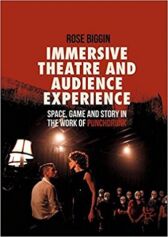Synopsis
Immersive Theatre and Audience Experience - Space, Game and Story in the Work of Punchdrunk
 $99.99
$99.99
Published by Palgrave Macmillan
Drawing on the author's role as embedded researcher within Punchdrunk, it provides fascinating insights into the company and suggests a variety of innovative approaches to immersive theatre
With its promises of empowerment, freedom and experiential joy, immersive theatre continues to gain popularity
But what exactly do we mean by audience "immersion"?
How might immersion in a Punchdrunk production be described, theorised, situated or politicised?
What is valued in immersive experience?
And are these values explicit or implied?
Immersive Theatre and Audience Experience draws on rehearsals, performances and archival access to Punchdrunk, providing new critical perspectives from cognitive studies, philosophical aesthetics, narrative theory and computer games
Its discussion of immersion is structured around three themes:
★ Interactivity and Game
★ Story and Narrative
★ Environment and Space
The book provides a rigorous theoretical toolkit to think further about the form's capabilities
It offers a unique set of approaches and will be of unique value to scholars, students, artists, directors, actors and spectators
TABLE OF CONTENTS
Chapter One
Immersive Theatre, Immersive Experience
This introductory chapter considers contemporary approaches to "the audience" in theatre, film and cultural studies, then redefines "immersion" with a model drawn from cognitive science, philosophical aesthetics and the study of computer games
Chapter Two
Interactivity and Immersion: Theoretical Approaches
The chapter outlines several models of interactivity from different fields, in order to discuss their various applications to immersive theatre and audience experience: digital and multimedia performance, including virtual reality and the idea of "presence"; improvisatory theatre and pervasive gaming; the experience economy; the theatrical event
Chapter Three
Interactivity and Immersion in The Drowned Man
Chapter Four
Fan Interactivity - Communicating Immersive Experience
Drawing on the author's exclusive access to Punchdrunk's archives, this chapter considers audience communication during Punchdrunk's Faust (2006) and The Masque of the Red Death (2007), and the development of international Punchdrunk fan communities around Sleep No More (2011) and The Drowned Man (20132014), to argue that audience participation or fan activity is itself a form of interactivity with immersive theatre
Chapter Five
Follow the Story - Narrative and Immersion
The role of "story" in immersive theatre is one of continual interest. After introducing several key concepts from narrative theory-outlining past and current models of discourse, plot, story, character and causality-the chapter proposes a means to apply these concepts to immersive theatre and audience experience, using Punchdrunk's linear immersive production The Crash of the Elysium (2011) as a case study
Chapter Six
Exploring Multistories: Narrative, Immersion and Chronology
Chapter Seven
Play the Story - An Approach to Narrative in Immersive Theatre
This chapter proposes an entirely new theoretical approach to the question of "story" in immersive theatre. Drawing from the field of computer games studies, Biggin introduces the (so-called) debate between narrative (or narratology) and ludology, two approaches to studying the role of story in games, arguing that this approach is highly applicable to immersive audience experience in theatre by its emphasis on the relationship between game mechanics, structure and story events. The usefulness of this model to immersive theatre is illustrated with analysis of Punchdrunk's Sleep No More (2011) and its 2012 partnership with MIT Media Lab exploring "long distance-real world interconnected theatrical immersion"
Chapter Eight
Environment and Site-Specificity: Space, Place and Immersion
Chapter Eight
Conclusion
SEE ALSO :
Devising Theatre with Stan's Cafe